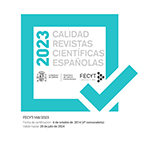Where does an Object End? Objects, Bourdaries and Intimacy in the Donation of Human Milk
Abstract
In our article we want to explore the plastic dimension of objects, their relationality. We use the well-known notion of “boundary-objects” (Leigh Star and Griesemer, 1989) to study the way in which the relationships in which an object is inserted modify its own status, and that of the people with whom it is connected (Winance, 2019). To do this, we turn to a case we have been studying for some time: altruistic donation of breast milk to hospital biobanks and other related practices of shared or "distributed" breastfeeding. We focus on three objects that have had a significant presence in our fieldwork: breastfeeding cushions and other similar tools, such as towels or blankets; breast pumps –popularly known in Spain as sacaleches, “milk extractors”–; and new probiotic drugs. Each of these three objects redefines, through its assemblages with breastfeeding practices, the boundaries between the nursing mother and the world –the relationships with pain and the body itself; social, family and friendship networks; and even the difference between the living and the inert, between body and medication. Each of these objects also participates in a peculiar way in what we call care or intimacy. An intimacy that, contrary to what is usually argued from “naive” humanist positions, is not constituted in opposition to the technical/“artificial”, but arises instead as an effect of the way in which heterogeneous –and always more-than-human– relations are materially mediated (Mol, Moser and Pols, 2010; Latimer and López, 2019)Downloads
Article download
License
In order to support the global exchange of knowledge, the journal Política y Sociedad is allowing unrestricted access to its content as from its publication in this electronic edition, and as such it is an open-access journal. The originals published in this journal are the property of the Complutense University of Madrid and any reproduction thereof in full or in part must cite the source. All content is distributed under a Creative Commons Attribution 4.0 use and distribution licence (CC BY 4.0). This circumstance must be expressly stated in these terms where necessary. You can view the summary and the complete legal text of the licence.











